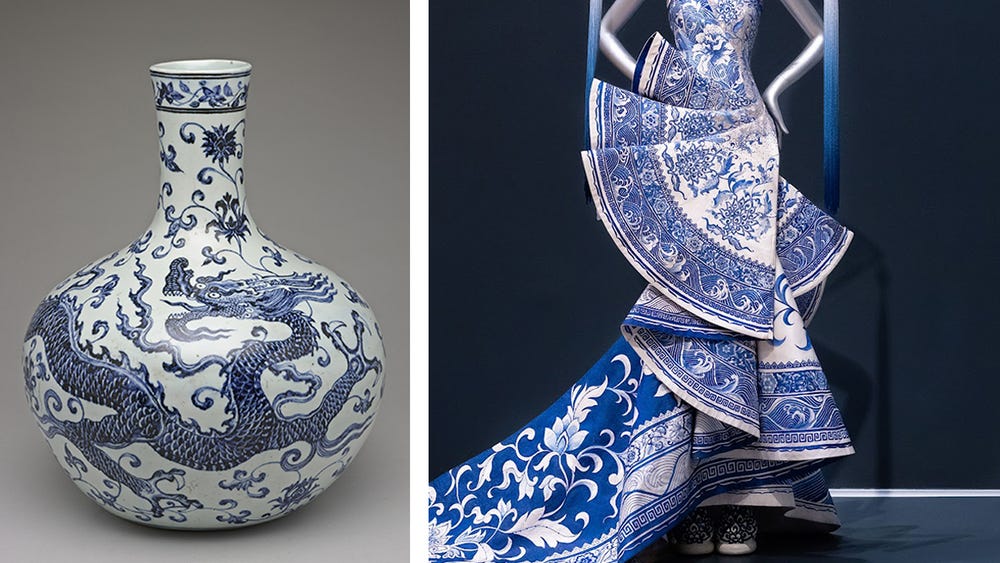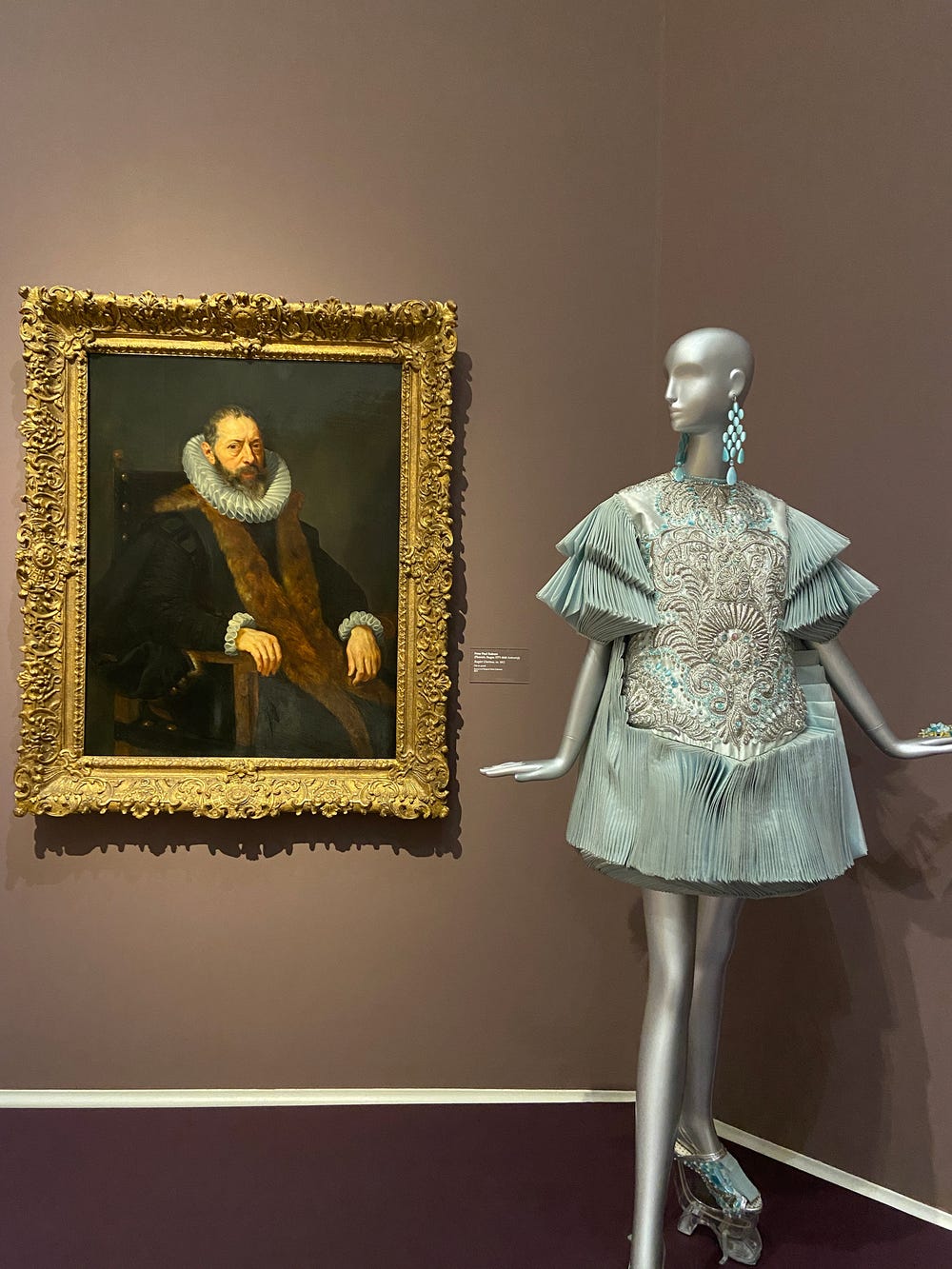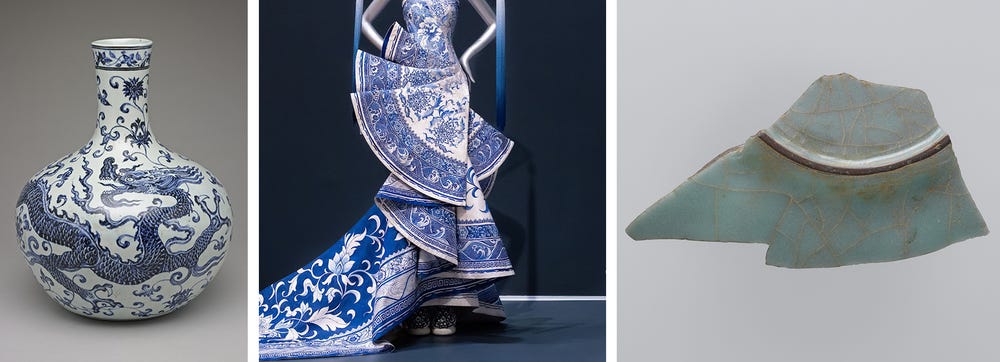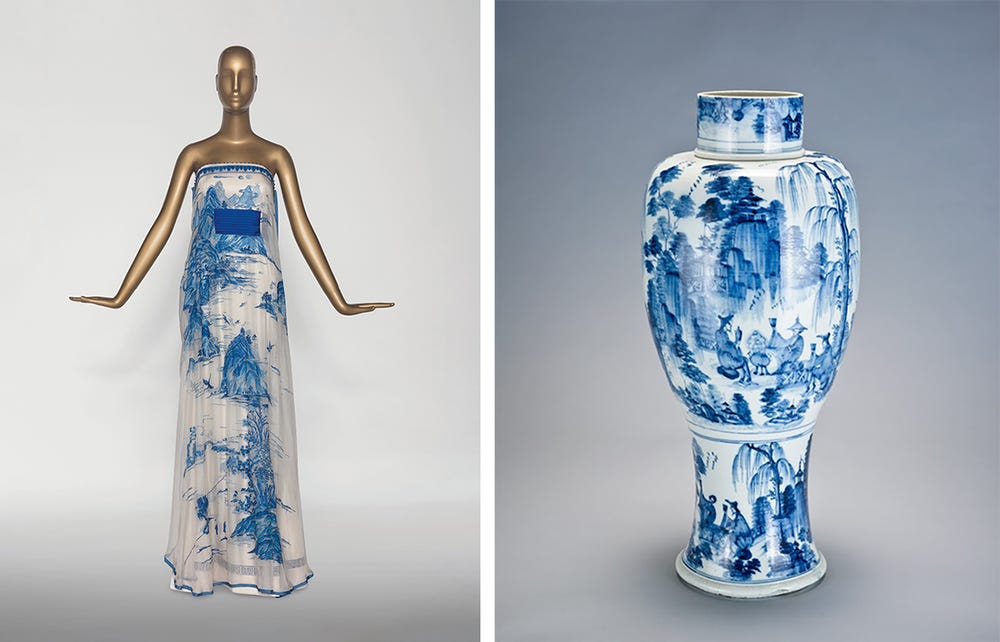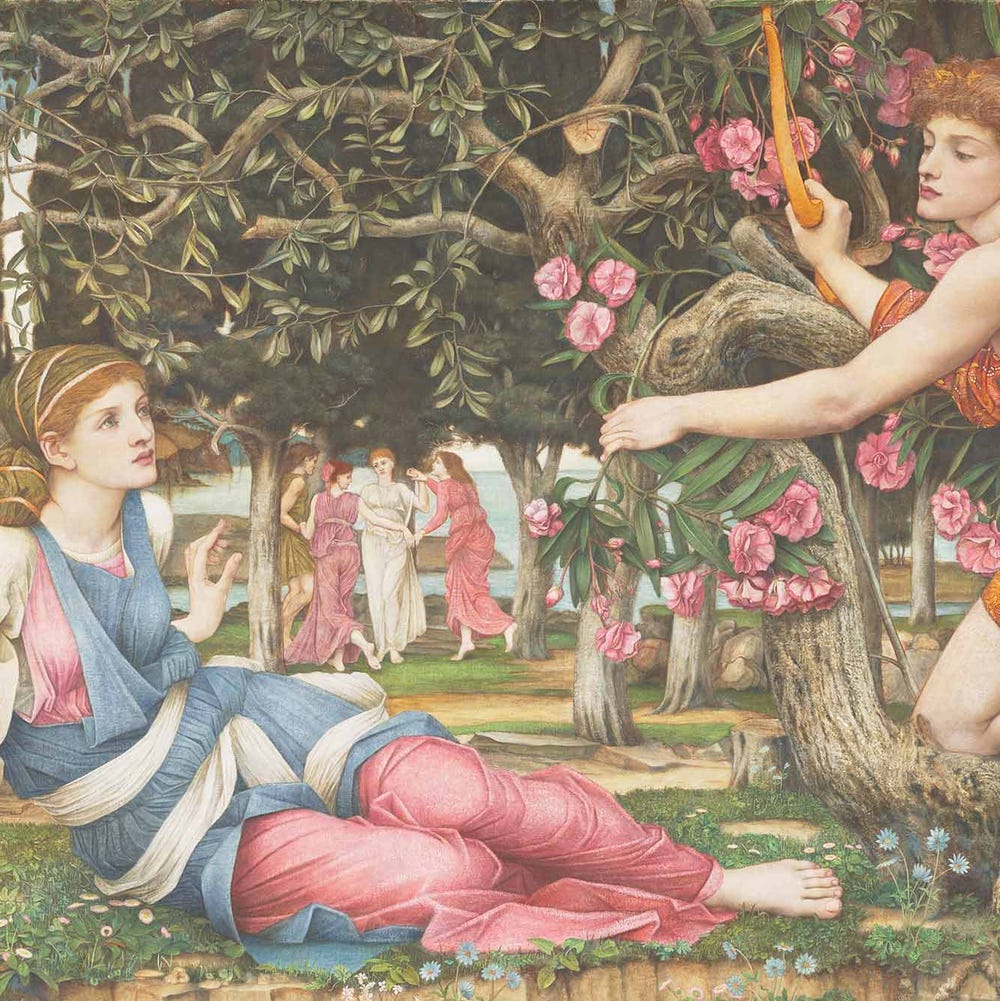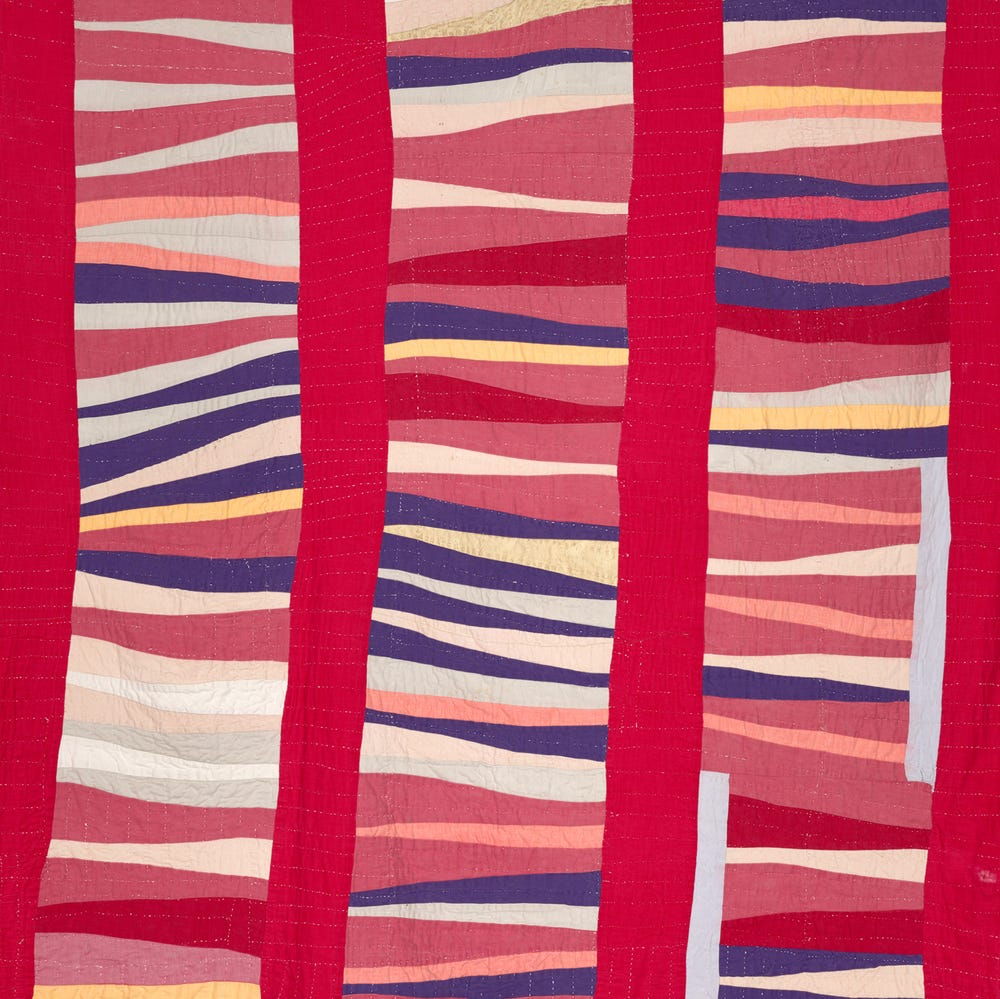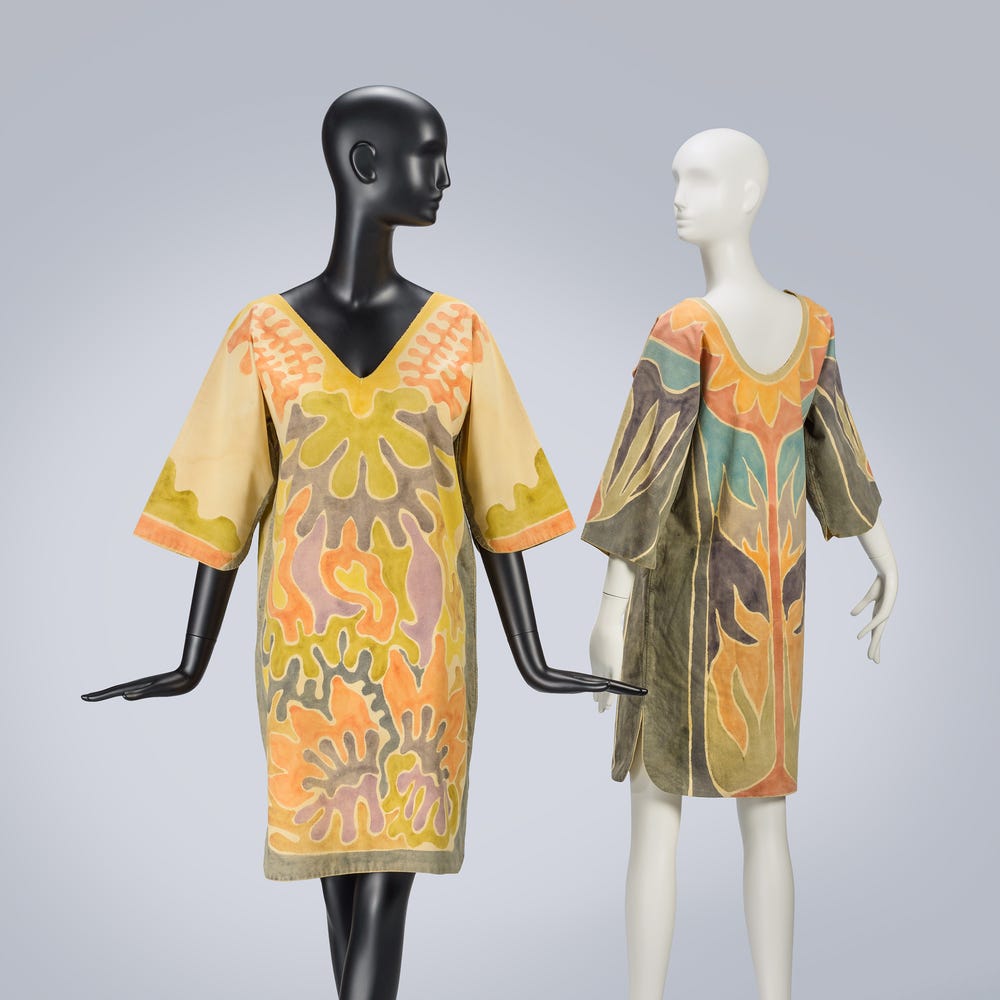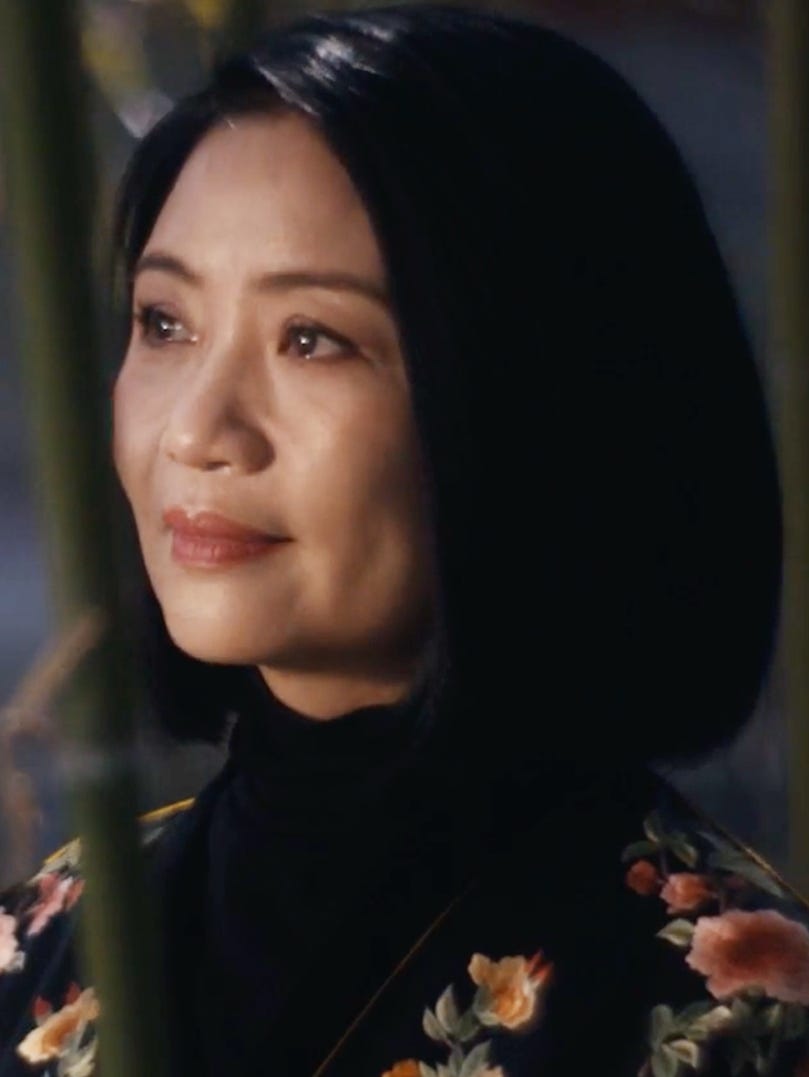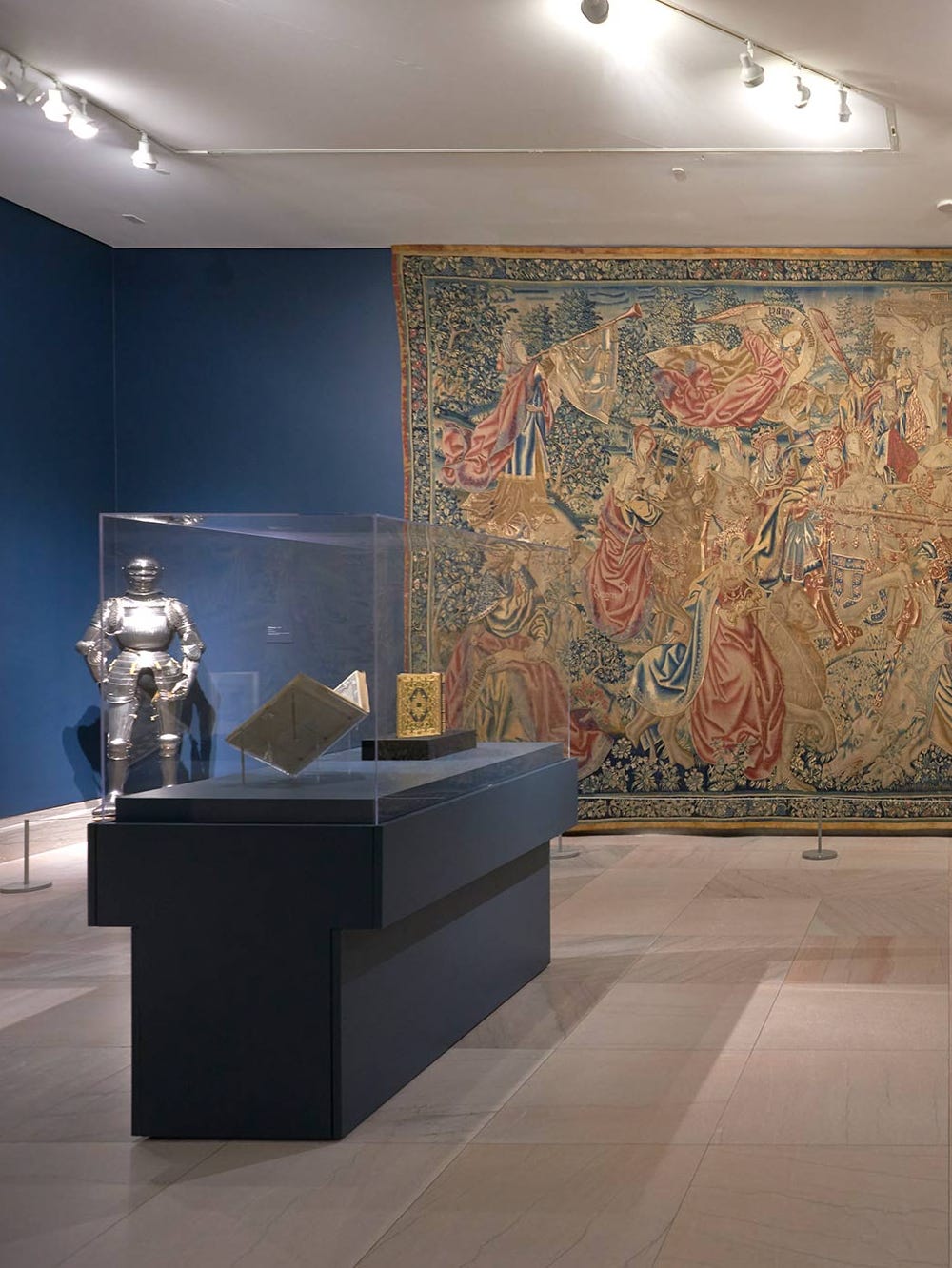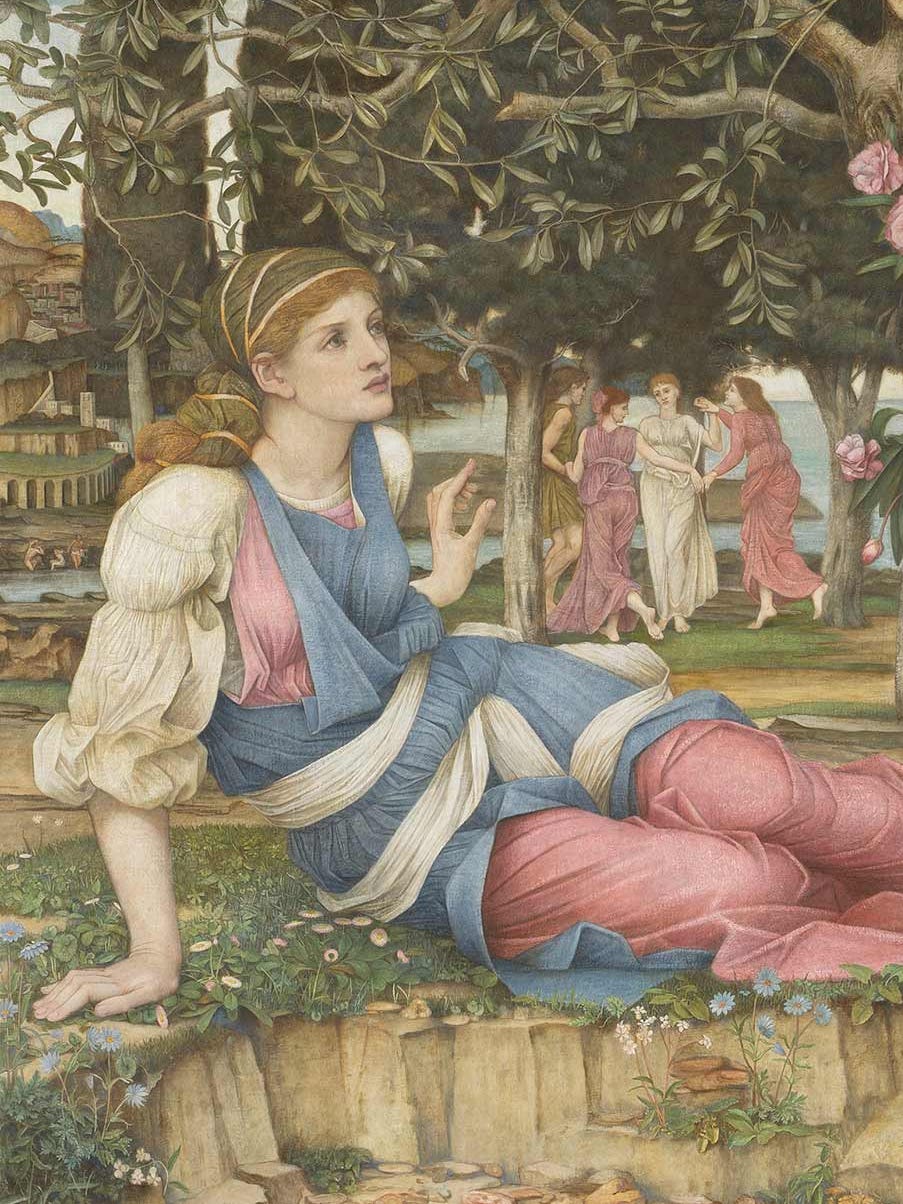(left) Vase with lotus and dragon decoration in underglaze blue, Yongle reign (1403 – 1424), Ming dynasty. Ceramic, h. 42.9 cm; diam. 9.7 cm; diam. of base. 15.8 cm. National Palace Museum, K1B011423 (right) Detail of dress from 1002 Nights collection, 2010, in installation of Guo Pei: Couture Fantasy, Legion of Honor, San Francisco, 2022. Photograph by Gary Sexton. Courtesy of the Fine Arts Museums of San Francisco
Guo Pei: Couture Fantasy features some 80 ensembles, each elaborately imagined, fantastically designed, and meticulously constructed. Walking through the museum, visitors witness ornament’s central role in the connection between Guo Pei’s wearable art and the decorative art featured in the galleries. In the permanent collection galleries in particular, the juxtaposition of Guo Pei’s dresses with the ornate borders and frames of the galleries’ artworks highlights the power of ornamentation, though such embellishment is typically regarded as marginal, peripheral, and even excessive.
Throughout the galleries, Guo Pei’s creations connect the paintings and drawings to ceramic objects from the 17th century, when luminous goods enchanted Europeans in a stylistic craze referred to as chinoiserie. The translucence of Peter Paul Rubens’s fabric pleats, particularly collars and sleeves, complements the diaphanous folds of two celadon dresses from Guo Pei’s 2007 collection, An Amazing Journey in a Childhood Dream. The pair of Rubens portraits in the Legion of Honor’s permanent collection present a husband and wife (Rogier Clarisse and Sara Breyel). Guo Pei offers a decidedly feminine form in the two dresses. In her construction of pleated extravagance, bodily form all but disappears beneath a mass of manifold expansions of the dress. Rather than supplemental — as in the garments worn by Rubens’s sitters — Guo Pei’s dresses position the ornamental as essential to the design’s composition. These dresses suggest that fairy tales and dreams are more than flights of fancy; they are a continuous source of strength. This concept is best expressed in the construction of infinitely continuous folds, where each bend meets another pleat and the boundaries between inside and outside, center and periphery, do not exist.
Installation image of Peter Paul Rubens’s Rogier Clarisse, ca. 1611, and a gown from Guo Pei’s collection, Amazing Journey of a Childhood Dream, 2007. Photo by Ellen Huang
The works that best exemplify ornament’s possibilities as a liberative language of design are Guo Pei’s dresses from the 2010 collection 1002 Nights. Inspired by and clearly referencing one of the world’s earliest global commodities (china) through its blue and white palette, the garments are not merely reflections of historical Chinese art and design. Rather, they play on the history of porcelain’s complex and cross-border interactions. The textual pun china (ware) and China (national identity) too easily reduces porcelain to a collectible or commodity; while porcelain has been referred to as chinaware, its history as both technological knowledge and object cannot be bound by the nation-fixing label China.
Installation view of Guo Pei: Couture Fantasy, Legion of Honor, San Francisco, 2022. Photograph by Gary Sexton. Courtesy of the Fine Arts Museums of San Francisco
The repeated historical attempt to overgeneralize the identity of porcelain as essentially Chinese has roots in centuries-long aestheticizing trends that have racialized overtones. Contemporaneous with the increased global demand for porcelain wares as trade and status objects was a parallel obsession with stealing scientific secrets of their manufacture. In a mirrored reflection of current geopolitics and global trade, porcelain embodied mercantilist states’ jockeying of resources toward industrial espionage.
A byproduct of this 18th-century obsession with porcelain’s composition was a positivist impulse for objective, “scientific” knowledge. One example is the Ballet des Porcelaines (or The Teapot Prince), first performed in 1739 outside of Paris and reimagined in this century by choreographer Phil Chan and the art historian Meredith Martin. The ballet is a tale of an evil sorcerer who turns trespassers of his domain into static porcelain objects. In defeat, the sorcerer himself turns into an absurd pagode — a term for a diminutive porcelain figurine popular in 17th- and 18th-century interior decoration — subject to derision and mockery for his robotic, techno-Orientalist function (examples here and here). At the heart of this fairy tale and Baroque ballet is the racialized objectification of the designers, artists, and craftsmakers behind these desired objects. To restage the work, which, as Martin writes, exists today only in fragments, is not an attempt to rescue historical authenticity but to raise questions about what “beauty might look like in a broken world.”
Guo Pei’s designs subvert the human-to-object transformation that took place in the Ballet des Porcelaines. Instead of reducing humans to objects, her garments re-animate the objects at the center of Europeans’ impulse to know, control, and ultimately subjugate.
(left) Vase with lotus and dragon decoration in underglaze blue, Yongle reign (1403 – 1424), Ming dynasty. Ceramic, h. 42.9 cm; diam. 9.7 cm; diam. of base. 15.8 cm. National Palace Museum, K1B011423 (center) Detail of dress from 1002 Nights collection, 2010, in installation of Guo Pei: Couture Fantasy, Legion of Honor, San Francisco, 2022. Photograph by Gary Sexton. Courtesy of the Fine Arts Museums of San Francisco (right) Sherd, Song dynasty (960 – 1279). Stoneware, Guan ware, 3 5/8 x 1 7/8 in. (9.2 x 4.8 cm). The Metropolitan Museum of Art, Gift of Judge Edgar Bromberger, 1942, 42.18.3
As if to echo the same inquiry about beauty in a broken world, Guo Pei’s porcelain dress is constructed through fragments, with pie-slice shards of a dish radiating from the center of the waist and skirt sections. Another design feature makes use of the aesthetics of brokenness, envisioning the headpiece as a porcelain vase, not unlike those made for Ming (1368 – 1944) and Qing (1644 – 1911) imperial courts. Its formal appearance, however, is obscured by a crystal-encrusted, fan-shaped pane. The zigzag pattern of the crystal structure evokes the cracks of broken ice, common in ceramic glazes of the Song period (960 – 1279). In its complete form, the gown consists of brokenness stitched together. Still, the individual fragments suggest movement, the garment’s semicircular features fanning from left to right while its vertical headdress glistens and dances. In Guo Pei’s reconstitution of the static objects at the center of European collecting practices, elements of decoration and display escape fixity and control.
Charger with Foliate Rim and Peacock Decoration, mid-14th century. Porcelain with decoration painted in underglaze cobalt blue, overall (max.): H. 8 × Diam. (across points) 48.9 cm (3 1/8 × 19 1/4 in.). Harvard Art Museums/Arthur M. Sackler Museum, Gift of Richard B. Hobart, 1961.112
The design of the dress speaks not to Chinese origins but to the mythology of origins. Blue and white porcelain overtook the world in the 14th through 19th centuries, first as designed objects for the Ottoman court and then for patrons of the Ming dynasty. By the 19th century, consumers spanning French Indochina, East African coastal cities, European palaces, and American households used blue and white ceramic products. Yet their Chinese origin is questionable: archaeologists have identified early prototypes of blue and white ceramics in excavations from west and central Asia. The metallic ore that was located, mined, and processed for painting blue ornament on white porcelain may in fact have emerged in Persianate regions, disrupting the Chinese-ness of chinaware. While European consumers during the 18th century fetishized “white gold,” ceramists in China’s Jingdezhen, who made the first blue and white porcelains for royal consumption in the 14th century, may have been manufacturing porcelain with white decoration on blue bases. The circular train of Guo Pei’s dress draws from these early porcelains — her embroidered designs feature white lotus blooms on a blue embroidered background — accentuating the ambiguity of chinaware’s origins and authenticity.
(left) Guo Pei, porcelain dress from the One Thousand and Two Nights collection, 2010. Copyright © Guo Pei, Asian Couture Federation. Photograph by Lian Xu. All rights reserved. (right) Meissen Factory (German, est. 1710), Baluster Vase, ca. 1722–23, Hard-paste porcelain with underglaze blue decoration. Collections of the Fine Arts Museums of San Francisco. Photograph by Randy Dodson, © Fine Arts Museums of San Francisco
As revealed in interviews, Guo Pei is interested in legends, tales, and myths. In her designs, silken threads, embroidery stitches, crystal adornment, textured layers, and material folds combine to convey kinetic movement. As such, her work defies definition while encouraging viewers to see beyond stale stereotypes of Asian women. This might best be seen in her blue and white gown depicting a spare idyllic landscape. In another nod to blue and white porcelain objects, a sheer fabric overlays the muted landscape composition underneath, creating a porcelain dress through layering. Such overlays increase the gown’s evanescent features. Its translucency may nod to the material of porcelain itself. But given the history of worldwide imitation in lower-fired ceramics, which highlights essentialist porcelain practices and global cultural exchange, the loosely draping gown emanates only the fantasy of this fantasy. Guo Pei’s designs, much like ornamental objects from China, are “ready to be seen as legendary,” as Chang’e sings in the 2020 Netflix film Over the Moon. Indeed, as the song tells us, they are “ultra-luminary.”
Text by Ellen Huang, Ph.d, associate professor of Humanities & Sciences, ArtCenter College of Design.
Guo Pei: Couture Fantasy is on view at the Legion of Honor from April 16 through September 5, 2022.
Resources
- Huang, Ellen. “From the Imperial Court to the International Art Market: Jingdezhen Porcelain Production as Global Visual Culture.” Journal of World History 23, no. 1 (2012): 115 – 145.
- Huang, Ellen . “Translating the Porcelain Pagoda of Nanjing.” In Jewels, Jewelry, and Other Shiny Things in the Buddhist Imaginary, ed.Vanessa R. Sasson (Honolulu: University of Hawai‘i Press, 2021), 208 – 41.
- Martin, Meredith, ed. Reimagining the Ballet des Porcelaines: A Tale of Magic, Desire, and Exotic Entanglement (London: Harvey Miller, 2022), 14 – 47.
